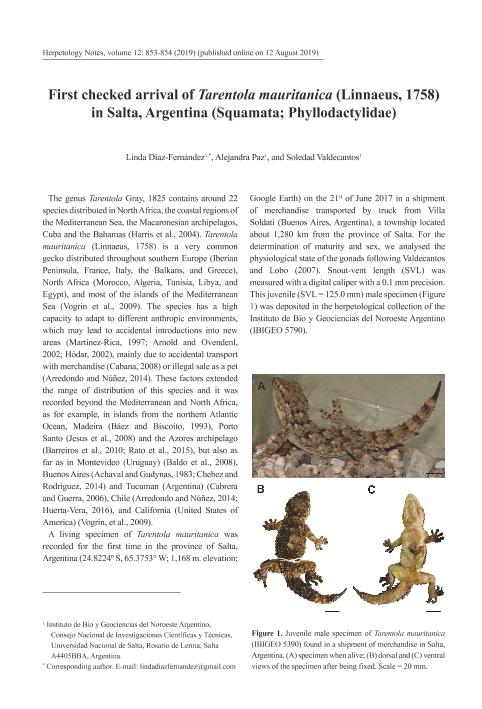Mostrar el registro sencillo del ítem
dc.contributor.author
Diaz Fernandez, Linda Erica

dc.contributor.author
Paz, Verónica Alejandra

dc.contributor.author
Valdecantos, Maria Soledad

dc.date.available
2020-12-17T02:57:10Z
dc.date.issued
2019-08-12
dc.identifier.citation
Diaz Fernandez, Linda Erica; Paz, Verónica Alejandra; Valdecantos, Maria Soledad; First checked arrival of Tarentola mauritanica (Linnaeus, 1758) in Salta, Argentina (Squamata; Phyllodactylidae); Societas Europaea Herpetologica; Herpetology Notes; 12; 12-8-2019; 853-854
dc.identifier.issn
2071-5773
dc.identifier.uri
http://hdl.handle.net/11336/120675
dc.description.abstract
The genus Tarentola Gray, 1825 contains around 22 species distributed in North Africa, the coastal regions of the Mediterranean Sea, the Macaronesian archipelagos, Cuba and the Bahamas (Harris et al., 2004). Tarentola mauritanica (Linnaeus, 1758) is a very common gecko distributed throughout southern Europe (Iberian Peninsula, France, Italy, the Balkans, and Greece), North Africa (Morocco, Algeria, Tunisia, Libya, and Egypt), and most of the islands of the Mediterranean Sea (Vogrin et al., 2009). The species has a high capacity to adapt to different anthropic environments, which may lead to accidental introductions into new areas (Martínez-Rica, 1997; Arnold and Ovendenl, 2002; Hódar, 2002), mainly due to accidental transport with merchandise (Cabana, 2008) or illegal sale as a pet (Arredondo and Núñez, 2014). These factors extended the range of distribution of this species and it was recorded beyond the Mediterranean and North Africa, as for example, in islands from the northern Atlantic Ocean, Madeira (Báez and Biscoito, 1993), Porto Santo (Jesus et al., 2008) and the Azores archipelago (Barreiros et al., 2010; Rato et al., 2015), but also as far as in Montevideo (Uruguay) (Baldo et al., 2008), Buenos Aires (Achaval and Gudynas, 1983; Chebez and Rodriguez, 2014) and Tucuman (Argentina) (Cabrera and Guerra, 2006), Chile (Arredondo and Núñez, 2014; Huerta-Vera, 2016), and California (United States of America) (Vogrin, et al., 2009).A living specimen of Tarentola mauritanica was recorded for the first time in the province of Salta, Argentina (24.8224º S, 65.3753° W; 1,168 m. elevation; Google Earth) on the 21st of June 2017 in a shipment of merchandise transported by truck from Villa Soldati (Buenos Aires, Argentina), a township located about 1,280 km from the province of Salta. For the determination of maturity and sex, we analysed the physiological state of the gonads following Valdecantos and Lobo (2007). Snout-vent length (SVL) was measured with a digital caliper with a 0.1 mm precision. This juvenile (SVL = 125.0 mm) male specimen (Figure 1) was deposited in the herpetological collection of the Instituto de Bio y Geociencias del Noroeste Argentino (IBIGEO 5790). It is evident that the geographical expansion of this invasive species is very quick. In this way, it is essential to highlight the importance of providing new geographic records and monitoring them, with the objective of preventing possible negative impacts, since the introduction of exotic species may lead to the destruction of natural resources and / or displacement of native taxa.
dc.format
application/pdf
dc.language.iso
eng
dc.publisher
Societas Europaea Herpetologica
dc.rights
info:eu-repo/semantics/openAccess
dc.rights.uri
https://creativecommons.org/licenses/by-nc-sa/2.5/ar/
dc.subject
Tarentola
dc.subject
Salta
dc.subject
Recorded
dc.subject.classification
Zoología, Ornitología, Entomología, Etología

dc.subject.classification
Ciencias Biológicas

dc.subject.classification
CIENCIAS NATURALES Y EXACTAS

dc.title
First checked arrival of Tarentola mauritanica (Linnaeus, 1758) in Salta, Argentina (Squamata; Phyllodactylidae)
dc.type
info:eu-repo/semantics/article
dc.type
info:ar-repo/semantics/artículo
dc.type
info:eu-repo/semantics/publishedVersion
dc.date.updated
2020-11-20T17:40:24Z
dc.journal.volume
12
dc.journal.pagination
853-854
dc.journal.pais
Alemania

dc.journal.ciudad
Bonn
dc.description.fil
Fil: Diaz Fernandez, Linda Erica. Consejo Nacional de Investigaciones Científicas y Técnicas. Centro Científico Tecnológico Conicet - Salta. Instituto de Bio y Geociencias del Noroeste Argentino. Universidad Nacional de Salta. Facultad de Ciencias Naturales. Instituto de Bio y Geociencias del Noroeste Argentino; Argentina
dc.description.fil
Fil: Paz, Verónica Alejandra. Consejo Nacional de Investigaciones Científicas y Técnicas. Centro Científico Tecnológico Conicet - Salta. Instituto de Bio y Geociencias del Noroeste Argentino. Universidad Nacional de Salta. Facultad de Ciencias Naturales. Instituto de Bio y Geociencias del Noroeste Argentino; Argentina
dc.description.fil
Fil: Valdecantos, Maria Soledad. Consejo Nacional de Investigaciones Científicas y Técnicas. Centro Científico Tecnológico Conicet - Salta. Instituto de Bio y Geociencias del Noroeste Argentino. Universidad Nacional de Salta. Facultad de Ciencias Naturales. Instituto de Bio y Geociencias del Noroeste Argentino; Argentina
dc.journal.title
Herpetology Notes
dc.relation.alternativeid
info:eu-repo/semantics/altIdentifier/url/https://www.biotaxa.org/hn/article/view/44961/50276
Archivos asociados
